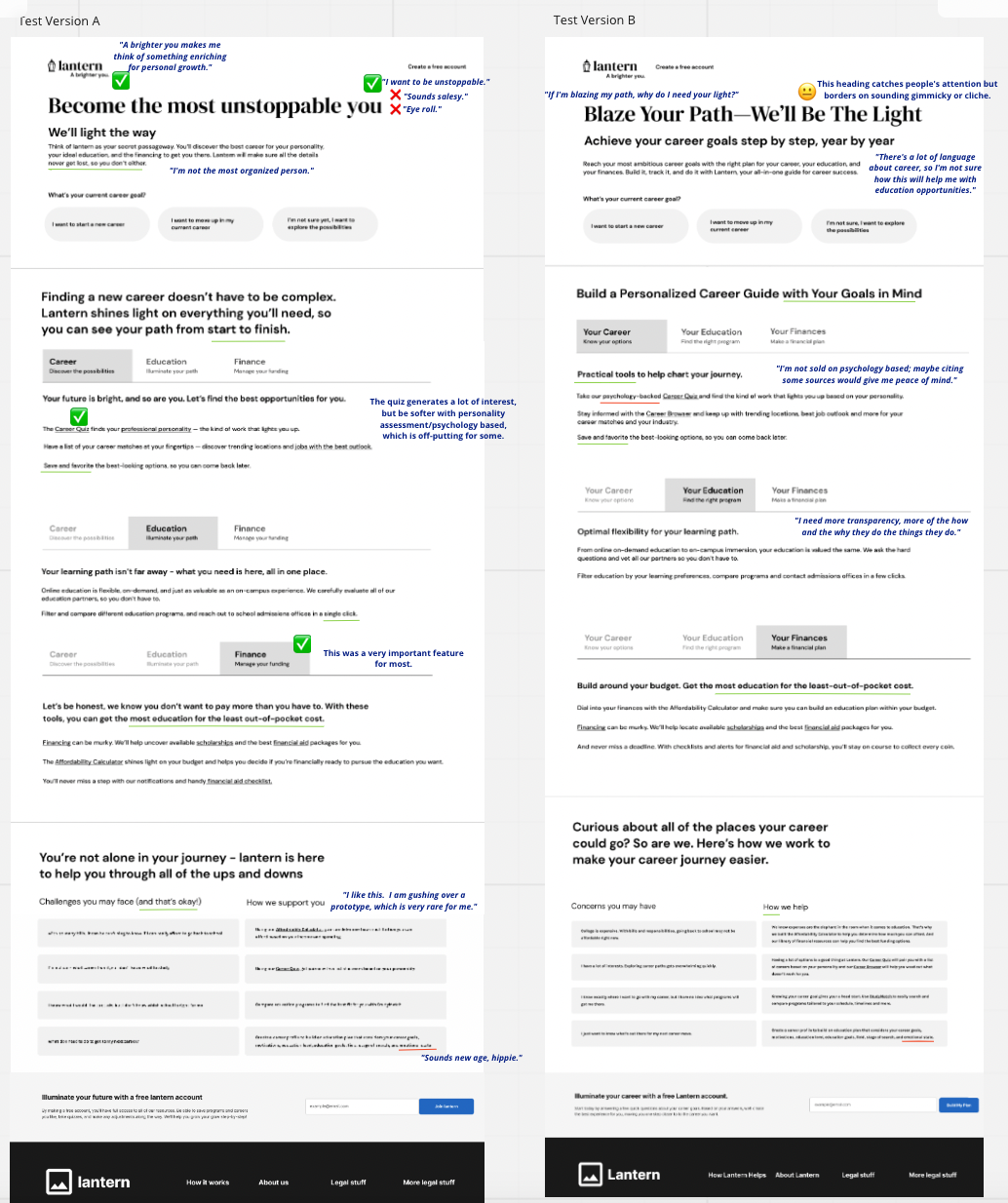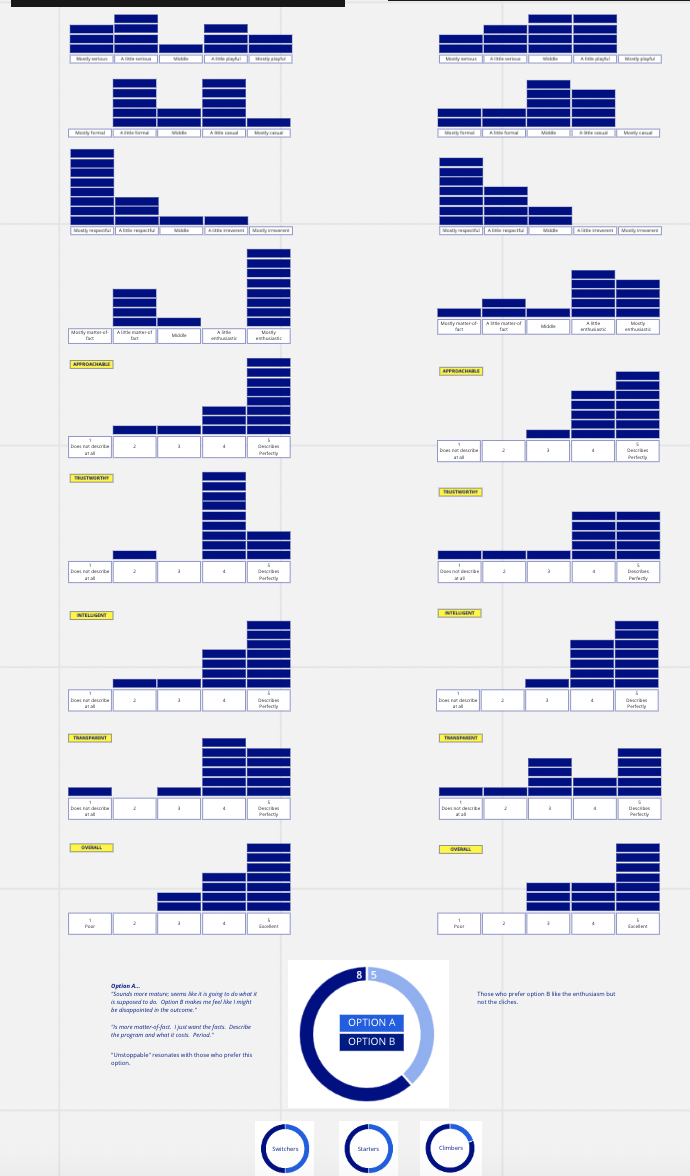I've led a variety of workshops for branding efforts, specializing in developing a unique brand voice and tone across a collection of sites. These workshops have been used to create new brands and also to rebrand existing ones.
The workshops in this series were used to develop a brand voice for a new product, Lantern. This brand voice example shows the complete process from ideation to launch of the MVP. Along the way, the brand voice was developing through a series of activities including familiar marketing exercises, unique storytelling work, and rounds of user testing.
| WORKSHOP 1: BUILDING A BRAND PYRAMID |
A brand pyramid is a tool that answers the fundamental questions about your brand's core principles in a pyramid like diagram that can be easily shared and communicated across your company. Stronger brands provide pricing power, have lower customer churn, and have lower advertising costs due to higher brand recall, retention, and trust. Strong brands inspire employees to stay and potential new hires to join.
This workshop takes on average about four hours. During this time, key stakeholders for the brand gather to brainstorm ideas of the key aspects of the brand pyramid: purpose, values, table stakes, benefits, personality, and promise. The personality portion of this workshop is based on Carl Jung's 12 Brand Archetypes. A deeper exploration takes place in workshop two of the series.
Post workshop, the ideas from the group are shaped into the layers of the brand pyramid, a document that makes it easy for anyone in the company to understand the fundamental principles of the brand.
For Lantern, the higher education tool highlighted in this example, the brand pyramid aligned on a foundation of being a trusted advisor guiding a student along their path to their career and education goals.
| WORKSHOP 2: DEVELOPING A BRAND PERSONALITY|
Next is developing the brand personality, the collection of characteristics with which your brand is expressed in the market. As humans, we connect best with other humans (or human-like creatures for pet lovers). A successful brand will remind a customer of a person, in some way, which will build a relationship with the brand, and loyalty. The goal of developing and expressing a brand personality is to make your brand more relatable, more likable and ultimately more human. The brand is conveyed through visuals and messaging to customers expressing what the brand is about and giving them a reason to choose one brand over another. The workshop takes about two hours.
This storytelling workshop is rooted in the fundamentals of good storytelling: a captivating hero (your customer) and an inspiring guide (you). This workshop is sourced from inspiration from Donald Miller's Storybranding framework and Carl Jung's 12 Brand Archetypes, but uses a combination of unique, storytelling activities to immerse participants in the realm of creativity. While workshop one focuses on aligning on a brand archetype, workshop two aligns on a customer archetypes early on to create a clear picture of the customer, the hero.
The next activity includes a series of rapid-fire questions designed to immerse participants into the imagination of the brand. The note and vote method is used here to allow everyone time to jot ideas on the onboard and then align as a group as themes emerge.
The final portion of this workshop is to have a conversation between the two established archetypes: the hero and the guide. Participants will create a conversation between the two as the hero attempts to navigate the product and the guide convinces them to convert. In this snipped from Lantern's workshop, three groups wrote conversations between the two characters.
Post workshop: After this workshop is complete, key words, notes, and ideas from the board are gathered to create rough guidelines for the brand voice. These are used to create a foundation for the next one hour workshop.
| WORKSHOP 3: ALIGNING ON TONE AND TAGLINE|
Now that the brand has principles, a personality, and a voice, having a scale to gauge the use of that voice and a tagline to highlight the underlying personality of the brand brings it home. The activities in this workshop are inspired from Nielsen Norman's 4 Tone of Voice Dimensions best practices and testing. This workshop takes about one hour.
In this workshop for Lantern, participants aligned on the tone of Lantern by refining the details. For example, while two groups agreed that Lantern should be "funny" on the Tone of Voice Dimension from Nielsen Norman, the "type of funny" had to be further refine with tone words such as "wit" vs "slapstick humor." A similar process occurred with creating the tagline, for example, several iterations of various puns on the words "light" and "bright."
Post workshop: Next steps are to draft a series of guidelines for the brand voice and tone based on the alignment from the previous three workshops.
| WRITING THE VOICE |
Once the workshop series is complete, during a brainstorm session, a brand voice chart is created. The voice chart centers the four main pillars of voice is developed to begin writing for the brand. A UX Writing Voice Chart is a tool designed by Torrey Podmajersky and described in her book Strategic Writing for UX. This voice chart is a foundation for a full style sheet and a quick reference across functional groups.
Once a voice chart is created, the guidelines to write the initial draft of the product content are drafted. If the voice is to be tested, additional work will need to be done to assess user responses and iterate until the brand voice aligns with the principles outlined in the brand pyramid workshop. For Lantern, additional work was done to further refine the voice. The remainder of this case study for Lantern is outlined below.
For Lantern, two voice charts were developed to conduct user testing and further refine the voice based on user feedback. Below are the two variations developed from the workshop series. Each aspect of the homepage design down to the capitalization in the footer was influenced by the individual voice chart drafted for Voice A and Voice B.
Each board was user tested. The users reviewed both homepage examples. Their responses included a range of vocal responses, open-ended written responses, and Likert scales.


After reviewing the feedback from user testing, one draft of Lantern's homepage was created encompassing feedback from both Voice A and Voice B. The final voice chart emerged. This homepage strategy was used to launch the MVP, which went through one final round of user testing before the product launch.
The brand voice was nailed according to the final user feedback.
This workshop lays the foundational work for the brand, but like all aspects of the business, the brand personality and voice will adapt as the customer base evolves. While this workshop launched the MVP voice for this product, as the features, function, and reach of Lantern morphed and expanded, the brand voice continued to grow. This concept video, demonstrates the future of Lantern post-MVP.
To learn more about building and hosting brand voice and tone workshops, use the "Chat" page to reach out.